Making Business Thrive Through Collaboration, Transparency and Employee Participation! For us, becoming a more agile company which is again successful over the long term started with changes in the company management.
Why did we need to change and set out in a new direction?
Ever since the incorporation of Saxonia Systems AG, which became ZEISS Digital Innovation in March 2020, the company had been growing continuously. But in 2008 and 2009, the crisis in the semiconductor industry and the nearly simultaneous financial crisis caused a severe drop in revenues. At the time, Saxonia Systems generated a large part of its revenues in the semiconductor industry, which is why the company’s crisis reached its peak in the middle of 2010. The main reasons for the dire situation were the unsatisfactory cooperation within the management due to the “kingdoms” that had emerged in the past, the lack of strategy and goals, and a lack of focus in the product portfolio.
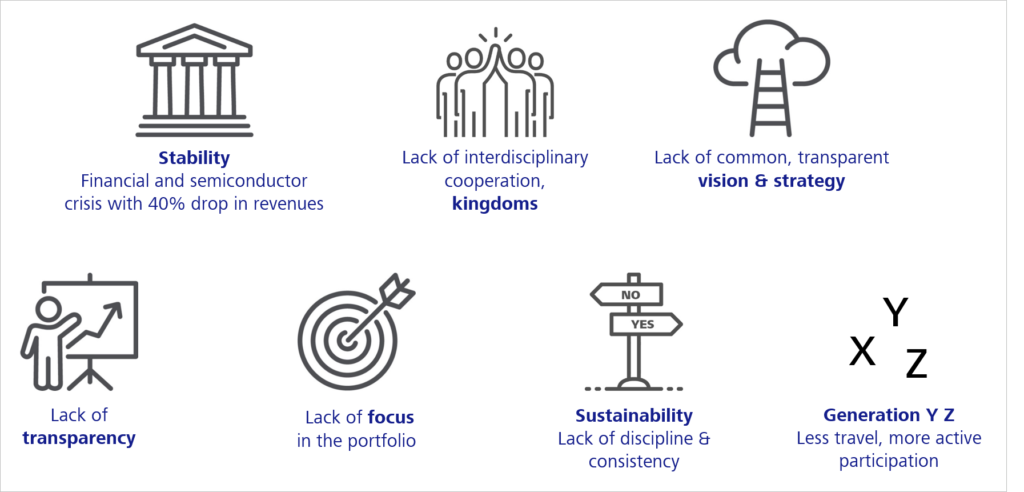
Where did we start the change?
The company’s management was convinced that a new form of cooperation and leadership was required—at every level, but starting with the management. From that point on, the management was supposed to work as a team, in keeping with the motto “United we are strong and can do anything.” The strategy team established at that time was well aware that the challenges outlined above could not be overcome on an operative level. In the past, each manager was trapped in their own operative rut. To enable them to leave it, we had to start on the next level up, i.e. with the strategic business management. If change is initiated there, that has a positive effect on all other management disciplines such as self-management, employee management, and operative business management. A strategy that is based on the employees’ contribution changes all the management areas. This is the only way to develop and agree on a vision and corporate objectives together. The management put this knowledge into practice, and to this day, the strategy team meets for a two-day strategy meeting three times per year. At this meeting, they address the current issues that are most important for the company.

However, a strategy team alone did not do the trick: the form of cooperation needed to be improved as well. The strategy team had to consider how everybody could become more disciplined and consistent as a team in the future, precisely to avoid developing strategies that only look good on paper. ZEISS Digital Innovation already had known and lived agility in its operative units in agile software development projects. Is the agile approach possible in management? The answer is perfectly clear: Yes!
In the end, the strategy team had no choice. To overcome the challenges they were facing, the management needed to cooperate much more closely and become more flexible, faster and, consequently, more agile. Therefore, the scrum method was adopted both in agile software development projects and in the management of the company. The result was the agile strategy process.
What has been the result of the continuous cooperation and improvement?
Over the course of the last 10 years, continuous optimization in the strategic work has resulted in a Best Practice Framework. It includes innovative and practicable concepts, methods, principles and tools that have enabled the company to overcome all the challenges it has faced so far. The Framework is meant to support the strategic work of ZEISS Digital Innovation in the future as well. The agile strategy process constitutes the basis for permanent transformation in our company, and the key element of the new form of cooperation across hierarchies, departments and locations.
The Framework that has evolved over time contains all the factors of success that allow for long-term corporate objectives to be achieved in a flexible manner:
- A corporate objective to be achieved and a strategy for achieving it
- Leadership and cooperation aligned towards the corporate objective
- An iterative, consistent and disciplined course of action to implement the prioritized strategic initiatives
- Common values and principles
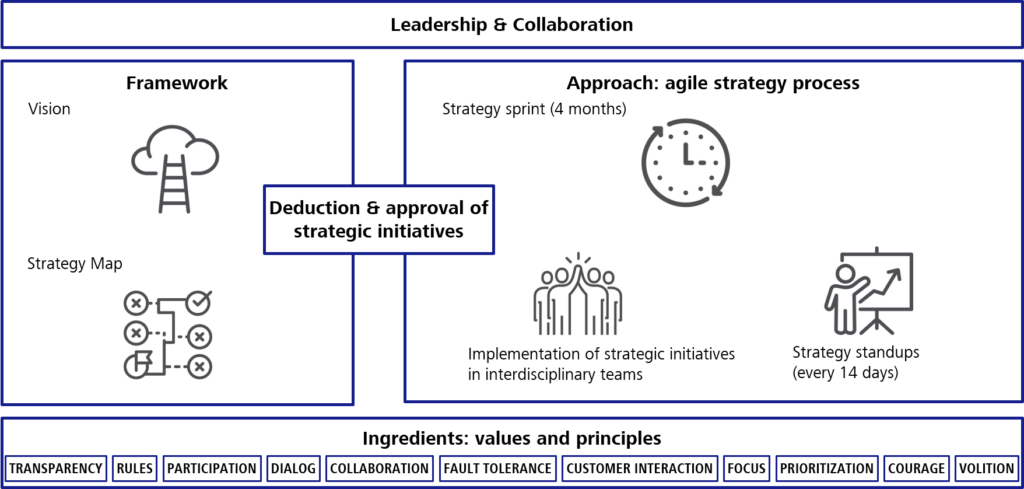
It is important to ensure that these four points are transparent throughout the entire company, and to continuously work on them—this builds trust among the employees. Only when everybody knows where they are headed and what the framework of objectives is, is it possible to pool and focus everybody’s strengths, energies and independent entrepreneurial activities within the company. Transparency towards the objective in particular constitutes the basis for all the employees to contribute their thoughts and ideas and help pave the way towards it. Transparency helps to avoid the duplication of efforts, to share knowledge, and to provide input for employees’ creativity. This often gives rise to valuable new ideas for the continued development of the company.
The iterative, step-by-step approach and the opportunity to actively participate in the company’s development allows for the employees to continuously be included in the journey of change towards our corporate objective. This way, continuous change in the company becomes the norm. And this facilitates commitment, employee loyalty and independent action. Intrinsically motivated employees are capable of great things.
How have we changed since 2010?
Still, nobody on the strategy team or in middle management of what is now ZEISS Digital Innovation expected our ambitious goals to be achieved this quickly. Here are some results, facts and figures to underscore the exceptionally successful development.
2010
Today
IT service provider for everything
with a business model in consulting

Specialist in customized software development
agile software development projects with well-coordinated teams at the company’s own locations
160 employees
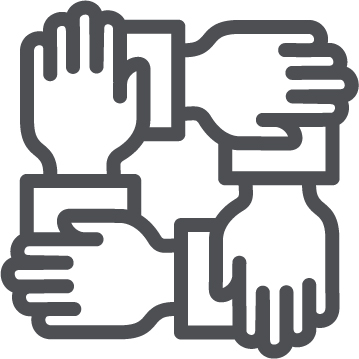
300 employees
Drop in revenue from EUR 17.3 to 12.9 million
EBIT -kEUR 500

Revenue EUR 35 million
EBIT EUR 3.5 million
(results of 2019)
Almost no interdepartmental collaboration
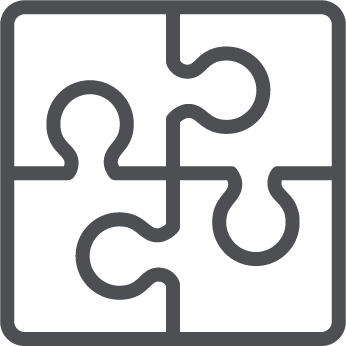
Intense interdepartmental strategic and operative collaboration
No common vision and strategy, lack of transparency

Target, strategy, strategy process
365d of transparency about the where, why, how and what
General store, lack of focus and sustainability
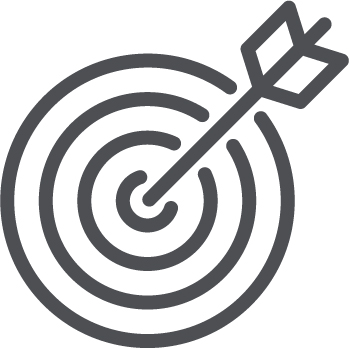
Total of 70 initiatives completed since 2010, 5 currently underway, award for portfolio attractiveness
Little ability to change

Change is the norm
Information and communication with the workforce twice a year at an in-house conference and the Christmas party

Intense 14-day company-wide information and communication regarding strategy / ZDI standups for all employees
No involvement of employees in the company’s continued development

Any employee who wants to get involved in strategic initiatives can do so—employees help pave the way towards the vision
Culture of finger-pointing, monopolies, expanding power, inconsistency, tattling, gossiping, everybody going their own way, mistrust…

Togetherness, openness, respect, appreciation, fun, emotions, independence, commitment, trust, dialogue, …
Saxonia Systems AG

ZEISS Digital Innovation
Part of the ZEISS Group
Why has this course of action been so helpful?
The course of action that has evolved based on our positive and negative experiences helps us to keep up with, and even keep ahead of, the ever-changing world. We are able to adapt and organize ourselves in a flexible manner without losing sight of our objectives. We join forces and focus on the respective high-priority issues that are beneficial to our continuous development.
Making our business thrive through collaboration, transparency and employee participation!

Within the framework of the permanent transformation initiated at the end of 2010, the company has achieved much, but it will not stop at that. Important basic elements of success that will continue to play a role for us will be addressed in other posts in this series.